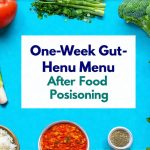Returning to solid foods after an illness – whether it’s a prolonged bout of flu, a severe gastrointestinal infection, post-surgical recovery, or even complications from COVID-19 – isn’t simply about resuming your previous diet. It demands a thoughtful and phased approach designed not just for nourishment, but also for gentle reintroduction to digestion and minimizing the risk of setbacks. The body has been through a stressful period, potentially experiencing reduced appetite, altered gut microbiome balance, and weakened digestive capabilities. A ‘post-recovery’ diet isn’t about restriction; it’s about strategic rebuilding, prioritizing easily digestible nutrients and slowly expanding dietary choices based on individual tolerance. It acknowledges that everyone recovers at their own pace, and what worked before illness might not be suitable immediately afterwards.
The key principle is to listen intently to your body. Signals like bloating, gas, diarrhea, nausea, or even fatigue after eating are vital indicators of intolerance. Ignoring these signs can hinder recovery and potentially lead to longer-term digestive issues. This isn’t a race; it’s about finding the right balance between providing adequate nutrition and respecting your current physiological state. Focusing on nutrient density – maximizing nutritional value with smaller portions – is paramount during this vulnerable period. A gradual, patient approach, coupled with mindful eating practices, will lay the foundation for long-term health and well-being post-illness. If you are struggling to return to normal, consider tips returning after a stomach episode.
Rebuilding The Digestive System
The digestive system often takes a significant hit during illness. Reduced intake, medication side effects (like antibiotics), and the inflammatory response itself can all disrupt normal gut function. This impacts everything from enzyme production to motility – the movement of food through the digestive tract. Therefore, rebuilding this foundation is critical. Starting with easily digestible foods allows the gut to rest and recover while minimizing stress on a weakened system. Probiotics and prebiotics, often found in fermented foods or supplements (consulting a healthcare professional before supplementation is vital), can help restore beneficial gut bacteria which are crucial for optimal digestion and immune function. If you’ve recently experienced digestive trouble, reintroduce solid foods safely.
A cornerstone of this phase is the BRAT diet – Bananas, Rice, Applesauce, Toast – but it shouldn’t be viewed as a long-term solution. It provides easily digestible carbohydrates and helps bind the stool if diarrhea is present, but lacks essential nutrients. Think of it as a temporary stepping stone. Beyond BRAT, incorporating other gentle options like well-cooked root vegetables (sweet potato, carrots), lean protein sources (poached chicken, fish), and low-fat dairy or plant-based alternatives (if tolerated) can begin to provide broader nutritional support. Hydration is equally important – water, herbal teas, and diluted fruit juices all contribute to overall recovery and aid digestive processes. If you’ve recently battled a stomach bug, reintroduce foods gradually.
The goal isn’t simply to avoid upsetting the stomach; it’s about actively supporting the healing process. This means prioritizing foods that are gentle on the gut lining and promote healthy digestion. Consider smaller, more frequent meals instead of large portions, which can overwhelm a recovering system. Chewing food thoroughly is also essential – this aids in mechanical digestion and reduces the burden on the intestines. Remember, the digestive system needs time to rebuild its strength and resilience. Comfort foods can play a role here too!
Gradual Food Reintroduction
Once you’ve established a base diet of easily digestible foods and are tolerating them well, it’s time to begin gradual food reintroduction. This is where mindful eating truly comes into play. Introduce one new food at a time, in small quantities, and monitor your body’s response for 24-48 hours before adding another. This allows you to identify any specific intolerances or sensitivities that may have developed during the illness. Don’t be discouraged if a previously enjoyed food now causes discomfort; it simply means your system needs more time to adapt.
Here’s a suggested approach:
1. Start with bland, low-fiber foods like oatmeal or well-cooked quinoa.
2. Introduce small portions of fruits and vegetables (steamed or cooked are best initially), starting with those known to be gentle on the stomach like blueberries or carrots.
3. Gradually add lean protein sources – a tablespoon or two of shredded chicken or fish.
4. Monitor for any adverse reactions: bloating, gas, diarrhea, nausea, fatigue. If you experience these symptoms, eliminate the new food and try again at a later time.
It’s crucial to document what you’re eating and how you’re feeling. A simple food diary can be incredibly helpful in identifying patterns and triggers. Don’t compare your progress to others; recovery is highly individual. Be patient with yourself and remember that setbacks are normal. The key is to learn from them and adjust your diet accordingly. If you have transitioned to a low-fiber diet and now experience constipation, address it proactively.
Addressing Potential Nutrient Deficiencies
Illness often leads to decreased appetite and nutrient absorption, potentially creating deficiencies in vital vitamins and minerals. While a well-rounded diet should ideally address these needs, supplementation may be considered under the guidance of a healthcare professional. Vitamin D, for example, is frequently deficient, particularly during winter months, and plays a crucial role in immune function. Similarly, iron deficiency can occur after prolonged illness or blood loss, leading to fatigue and weakness.
Focusing on nutrient-dense foods is the first step towards addressing deficiencies. Foods rich in protein support tissue repair, while those containing healthy fats provide energy and aid in hormone production. Incorporating a variety of fruits and vegetables ensures adequate vitamin and mineral intake. However, if dietary changes aren’t sufficient, supplementation may be necessary.
Important Note: Self-treating with supplements can be harmful. It’s essential to have your nutrient levels assessed by a healthcare provider before starting any supplementation regimen. They can determine the appropriate dosage and ensure that the supplement doesn’t interact with any existing medications. Remember, food should always be the primary source of nutrients.
The Role Of Gut Microbiome Support
The gut microbiome – the trillions of bacteria residing in our digestive tract – plays an indispensable role in overall health and recovery. Illness, especially those involving antibiotics, can disrupt this delicate ecosystem, leading to imbalances known as dysbiosis. Restoring a healthy gut microbiome is therefore crucial for improving digestion, boosting immunity, and reducing inflammation.
- Probiotic Foods: Include fermented foods like yogurt (if tolerated), kefir, sauerkraut, kimchi, and kombucha in your diet. These foods contain live beneficial bacteria that can help repopulate the gut.
- Prebiotic Foods: Feed the good bacteria with prebiotic-rich foods such as onions, garlic, leeks, asparagus, bananas, oats, and apples. Prebiotics are types of fiber that act as food for probiotics.
- Consider Supplementation (with professional guidance): Probiotic supplements can be helpful in restoring gut balance, but it’s important to choose a high-quality product with multiple strains and consult your doctor before starting.
A healthy gut microbiome is not just about digestion; it’s about overall well-being. It influences everything from mood and cognitive function to immune response and chronic disease risk. Investing in gut health is an investment in long-term recovery and resilience.
Beyond The Basics: Tailoring Your Diet
Once you’ve successfully reintroduced a wider range of foods, the focus shifts towards tailoring your diet to your individual needs and preferences. This involves considering any pre-existing conditions, allergies or intolerances, and lifestyle factors. For example, someone with diabetes will need to manage carbohydrate intake carefully, while someone with heart disease may need to limit saturated fat.
It’s also important to recognize that recovery isn’t linear. There will be days when you feel stronger and can tolerate more food, and days when your digestive system feels more sensitive. Learning to adapt your diet based on these fluctuations is key. Don’t be afraid to scale back if you experience discomfort, and don’t feel guilty about prioritizing rest and nourishment over strict dietary adherence. Self-compassion is essential during this process.
Ultimately, the goal is to create a sustainable eating pattern that supports your long-term health and well-being. This may involve working with a registered dietitian or nutritionist who can provide personalized guidance based on your specific needs and goals. They can help you develop a balanced and enjoyable diet that fuels your recovery and empowers you to thrive. Remember, food is not just fuel; it’s medicine – and the right dietary choices can make all the difference in your journey back to health. If transitioning to a grain-free diet results in constipation, seek solutions.


















